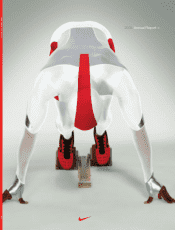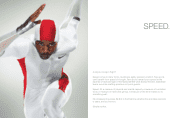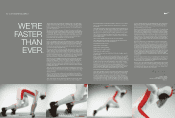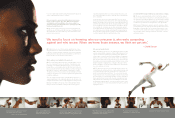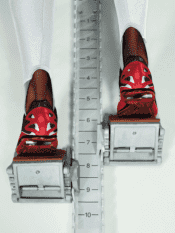Nike 2004 Annual Report Download - page 3
Download and view the complete annual report
Please find page 3 of the 2004 Nike annual report below. You can navigate through the pages in the report by either clicking on the pages listed below, or by using the keyword search tool below to find specific information within the annual report.
WE’RE
FASTER
THAN
EVER.
TO OUR SHAREHOLDERS >s
Twenty-three years ago I began my chairman’s letter, “This publication
marks a milestone in Nike’s history…” That was 1981, our first year as a
publicly owned company. In the years since, I might have reprised that
lede for many reasons. This year is no exception. Fiscal Year ’04 was the
best year in Nike history.
We crossed $12 billion in revenue, a 15 percent increase over last year,
with 27 percent growth in earnings per share. In fiscal ’04, our international
pre-tax profits grew by nearly a third and generated more than half of our
overall profits. Nike exceeded the return of the S&P 500 by more than 10
percent for the year. We’re 30 percent better over five years. And as for
the long term (at least in today’s cut-and-run environment), we more
than doubled the S&P 500 growth over the last decade.
By any measure, Nike had a banner year.
Even so, the attempt I made in my first chairman’s letter
—
to impart some
clear understanding of what Nike means
—
remains as elusive as it was
back in 1981. So I thought I would take a look back at the chairman’s
letters written in the interim with the idea it might give you some insight
into who we are and where we are going. (If you question the premise,
you may as well quit reading right now.)
When we went public in 1980, we had 7,500 original investors. I placed a list
of those names on the credenza behind my desk. Every morning, as I sat
down to begin the day, I saw those names, the people who understood
enough about Nike and what we were trying to do to put their hard-earned
money into a fledgling company
—
small and quick to be sure, but risky just
the same. That list of names was a powerful reminder of the people for
whom I was working. I continue to work for those people today.
Now there are over 150,000 shareholders, all benefiting from our simple
story of growth by commitment.Through it all, the fits and starts, the
problems, the triumphs, I can see, as clear as a silver cord in the sun,
the thread that ties the Nike story together. And I can see, over my
shoulder, statements made in past chairman’s letters that seem almost
prophetic and could easily apply today. (I’ll not talk about all those things
I said that were wrong.)
1982: “It is extremely enjoyable and enormously satisfying to look back on
the last 10 years. It really has been a decade of victory. But we do not and
cannot spend much time in reflection. We are busy and our most exciting
decade lies ahead.”
1983: “The next five years hold as much uncertainty as has existed in
decades
—
but also as much excitement and opportunity. I believe those
companies which will be successful will be those with good management
and a good market position. We have both.”
1984: “In fiscal year 1984, we made over $40 million in net income, which
represents a 16 percent return on equity. There are many companies
that would thankfully accept that performance. Nike is not one of them.”
1985: “I still would not trade Nike’s place with any other company in
the industry.”
1986: “What the future holds for this industry and this management is,
of course, uncertain. The final question is, Can we compete? In China
they say you can’t escape your tradition. Our tradition grew out of a
laundry room in Southeast Portland. Compete, I promise you, we can do.”
1987: “And the most important thing is that all the areas in which we
made progress during the year laid the foundation for what promises
to be a brilliant future.”
1988: “I believe that Nike’s people are the envy of the industry.”
1989: “Our business is exportable. There is at least as much potential
in other markets as there is in the United States.”
Along the way we grew in form.
Single product, single market.
Single product, multiple markets.
Multiple products, multiple markets.
Multiple brands, multiple markets.
Through it all there were three big themes that made it happen: people,
people, people.
Make no mistake: we have been tested mightily. Between 1998 and 2001,
the management that I praised in the ’80s had a tough time keeping
up with sales, which more than doubled between 1994 and 1997. I expected
it to take some time for them to grow into our revenues. It did. And they did.
In 2001 some people were asking if Nike was still a growth company.
This past fiscal year our sales grew $1.5 billion. We all work in a terrific
industry
—
shoes, clothes, accessories and equipment
—
and its
momentum is gathering around the world. This year Nike Russia came
online, joining Nike Brasil, Nike China and Nike India as Nike-owned
frontiers in the world’s largest and fastest growing economies.
Yes, there is lots of room to grow.
Three quick examples. First, we’re becoming a golf equipment company.
Tiger, who will be back, had his toughest year. Result: record golf sales.
(It’s not just the athlete.)Second, a shoe called the Air Zoom Total 90
became the biggest selling soccer boot in the “big five” European
countries during the 4th quarter, making Nike the marketshare leader
in soccer footwear in Europe
—
unfathomable by the world a decade ago;
unspeakable by some today; yet fated to Nike because we committed
our unique passion and skills to the game. Third, while Nike was hitting
on most cylinders this year, our subsidiary brands
—
Cole Haan, Bauer
Nike Hockey, Converse and Hurley
—
are now up and over a billion
dollars in revenue. You want to see an opportunity for Nike akin to
becoming global? Look to the subs.
Despite our youthful and well-intentioned resistance to it along the way,
Nike is gaining maturity, an attribute you cannot pursue but rather is
thrust upon you. It happens when you willingly accept responsibility
for your potential; it happens when you survive those things that are
beyond your control. Even so, when you choose to focus on the fine,
indeterminate line that is the horizon, life and business will never be
perfectly precise. Your views and actions must continually adjust for
a degree or two of uncertainty. We welcome that. It is how we gain
wisdom, how we survive, how we become strong. It is how we grow
into ourselves.
And yet for all we have seen and learned, for all our scars and grins,
Nike remains a kid at heart. Just a few weeks back, on the Michael
Johnson Track here at World Headquarters, we celebrated the 50th
anniversary of Roger Bannister and his royal performance as the first
to crack the 4-minute mile. Providence was ours that day. Michael
Stember won the Inaugural Nike Invitational Mile with a time of 3:59.4 –
matching exactly the good doctor’s time set 50 years earlier. Also
running that day, a kid from Portland named Galen Rupp, who finished
at 4:01.8, shattering the Oregon high school record by three seconds.
Yes, I said high school. It was a magical day for more than 2,000
screaming Nike employees crowding the track. This is the Nike that
will always be.
Amidst this atypical reminiscence, and underlying all the heady emotion
of our industry, I am reminded of the unforgettable lessons of finance
professor James T.S. Porterfield, who thundered in the classroom,
“Shareholders are the deity that you serve.”
And so I say to our shareholders and to our Nike people alike, I believe
our record over 24 years as a public company is very good. It is why
I can stand in this space one more time, look you in the eye and say
what I said twenty years ago, and what I hope to say 20 years from
now, “We are very optimistic about our future.”
Philip H. Knight
Chairman of the Board,
Chief Executive Officer &President
NIKE,Inc.

